Up-to-date plant protection and weed control technologies of medicinal plant production
Authors: Péter Radácsi and Péter Rajhárt
What is plant protection, what do we have to protect against?
First of all we have to define what the word plant protection means. According to the XXXV. law of 2000. plant protection can be described as follows: to secure coordinated, effective action to prevent and to control the introduction and spread of pests of plants and plant products. On the score of these facts we can separate abiotic or climatic factors (hail, drought, frost damage) and biotic factors. This topic focuses on the protection against the biotic factors. Usually we classify these facts into three main groups: 1. Pests (insects, mites, eelworms, rodents, big games) 2. Diseases (fungal/bacterial diseases, viruses, phytoplasms) 3. Weeds. In the spite of the weeds staying in the third place in this specification, we need to be aware of the fact that the usage of herbicides is the most widespread in case of pesticides. According to KSH’s data from 2000 herbicides are applied on 25 %, while against pathogens on 10 % and against pests only on 9% of total territory of Hungary. So we can state that the areas treated with herbicides are 2-2.5 times bigger than areas treated with other chemicals.
The importance of plant protection
The importance of plant protection is questioned many times. While we can throw away a „grubby” apple grown in our own garden, we can not do the same in a professional orchard. It is especially true in the case of the MAP (Medicinal and Aromatic Plants) where the biomass production is not only the first and only aim of the production. Three factors can influence the profitability of production in the case of wrongly or not applied plant protection. First the damaged crop develops less biomass so the yield is decreasing and the quantity is also deteriorating. It can be an aesthetic problem (stained, discoloured leaves, mastication) but on the other hand it can significantly reduce the amount of special agents (eg: Quantity of the essential oil of tutsan leaf infected by phytoplasm decreasing with 60% compared to healthy leaf.) Summarizing this two factors, in the case of MAP the reduction of special agent yield can be significant. Accordingly we can say that the properly applied plant protection technology is the basis of the economical crop production. We must not ignore the fact that chemical control has serious environmental impacts. We use 2.5 million tons of pesticides a year and we cause 100 milliard $ damage with it.
The features of plant protection and the medicinal plant sector
If we speak about medicinal plants we should not forget about the three important attributes that the plant must possess: safety-quality-efficacy. If the applied plant contains significant pesticide residue, the criteria of quality is weakening. It is especially true for those medicinal plants where we expect therapeutic effect but the contaminated plant can be harmful to health. Nowadays there is a great importance of the residue-free MAP production. On the other hand there is a serious pressure and requirement for more and higher quality drugs. It includes that the drug must be free from pests and diseases of course. You can achieve this in the case of proper pesticide registration for MAP crops or by working out and up-to-date plant protection technologies. If we look at the current list of authorized pesticides in Hungary, there are only eleven MAP crops mentioned in it.
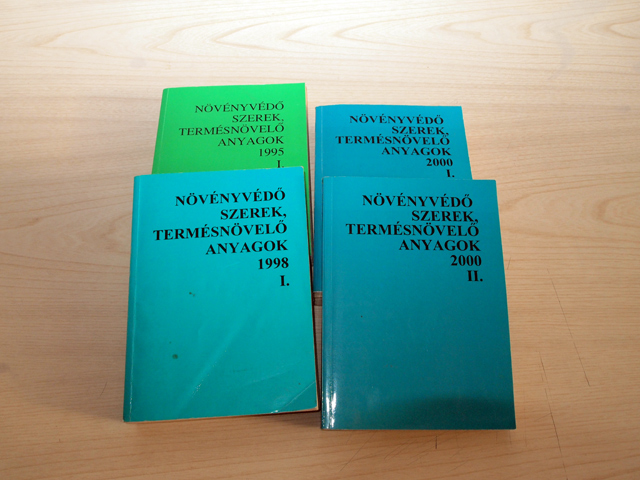
Certified pesticides and yield enhancing substances (Photo: Radácsi)
Map crops with certified pesticides
|
The majority of these plants can be cultivated by field cultivation technology: mustards (Sinapis spp.), caraway (Carum spp.), poppy (Papaver somniferum). If we take into consideration the richness of species cultivated as MAP crops, we need to realize that there is not enough information for MAP grower farmers. The main reason is that the pesticide registration for each crop (one-by-one) is very expensive. That is why the „small” crops (few, few hundred ha) are unable to economize for the huge investment of the registration process. The Plant doctor or Plant protection engineer has a possibility to ask for an occasional licence. The 89/2004 (V.15.) FVM decree and modifications are regulating the registration of pesticides. In the past 60 years many MAP crop’s production technology has been elaborated, including the chemical plant protection of course.
Knowing the fact that the MAP’s special agents are active biological substances, the risk of the interconnection between the active agents of the plant and the pesticide is not negligible. The domestic medicinal plants are ranked into three hazard categories on the basis of the connection risk of active agents and the way of their usage. The first category consists of those medicinal plants which are used in „self-medication”. We use them mainly as dry spices or tea at home (chamomile, rosehips, dill, anise), so the pesticide residue on the plant surface can directly get in the human body. In this category we need to pay attention to the chemical plant protection, but the most effective method is avoiding synthetic chemicals. The second category’s (lavender, clary sage) plants undergo an extraction before usage. Due to this process the pesticide residue connected to the plant’s dry matter separate from the special agent of the plant. Therefore the end product does not (or only in a minimal amount) contain pesticide residue. The third category is the industrial use of plant (nightshade, periwinkle, and foxglove) where the active agent recovery is a complex extraction process. In this way the residue can be separated from the end product under the procedure.
WHO’s recommendation issued in 2007 emphasize that the foods and MAP are derived from the same primary commodity, therefore the quality assurance of the food industry and medicinal plant production are closely related to each other. Nevertheless we should note that there are many differences between the two activities, that's why further considerations concerning to medicinal plants are necessary. WHO defines the daily intake of residues drive from medicinal plants in 1% of the total residue intake, including all the other food and drinking water. Because we use the medicinal plants as a long-time treatment, we have to define the maximum residue level: residue’s maximum permissible concentration is given in mg/kg. Recommendation (GACP) for MAP production issued by WHO suggests to minimize the pesticide use in the case of medicinal plants. We should make an effort to use integrated approach in the crop production, as well as, apply the chemicals in minimal effective dose. We have to apply the correct application methods and take into consideration the proper working and health protection conditions.
Options for chemical plant protection
Fortunately the plant protection is not limited only to the chemical pest control. The agricultural technology, mechanical plant protection, use of species and varieties ( utilization of tolerant, resistant and special morphological features) can be an optional and support the efficacy of chemical pest control. It is important to know that the pesticides registered in any EU countries are not accepted automatically in other EU countries. Recently there are many pesticides registered for MAP based on many scientific results and financial support in Germany. The list of these pesticides is published in the journal Zeischrift für Arznei-und Gewürzpflanzen regularly.
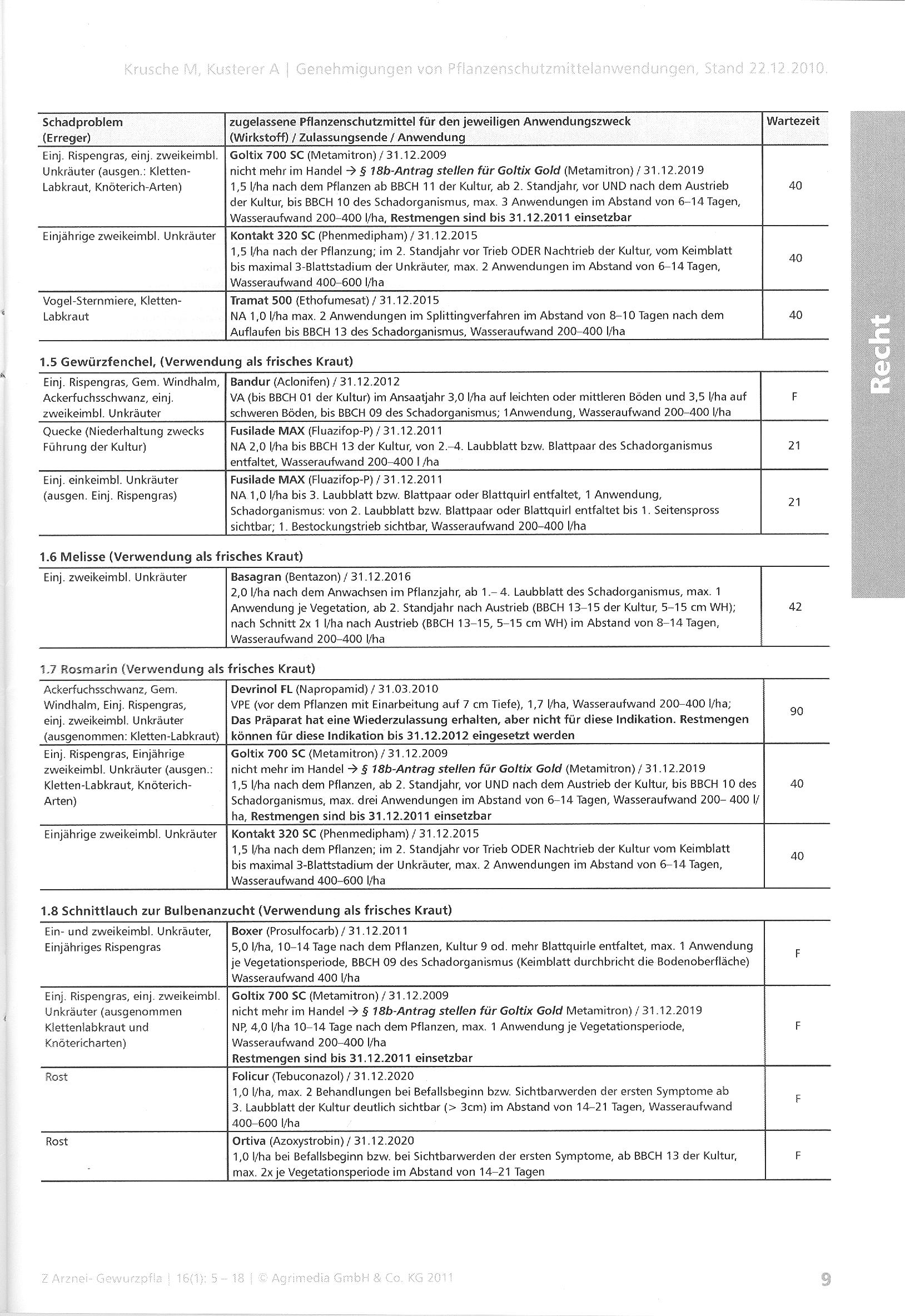
Registered pesticides for MAP crops in Germany (Zeischrift für Arznei und Gewürzpflanzen, 2011/16)
The concept and use of "gentle plant protection"
Nowadays people think that gentle plant protection is synonym of organic farming. The main feature of large-scale, conventional crop production is the usage of synthetic pesticides in large volume. Most of the cases pesticides are used for symptomatic treatment not for prevention. In the case of organic farming the prevention and protection with agricultural technology became the most important. The IMFAO (International Federation of Organic Agricultural Movements) directives and regulations of the EU forbid the application of any synthetic biocidal and herbicide products. The list of permitted pesticides in organic farming can be found on the home page of Biokontroll Hungária Nonprofit Ltd. Recently there are many research done concerning the application of medicinal plants and their active agents in plant protection. Several results are published in scientific journals about in vitro experiments. Unfortunately the results of in vitro experiments are not proved in practice. Negligible percentage of commercial pesticides contains active agents isolated from MAP, some of them contains essential oil. The products of ECOPCO company are exceptional because they contain essential oils of different plants. Application of volatile oils in plant protection may have some drawbacks:
-
The appropriate application is difficult
-
The active agent is relatively expensive,
-
It can be phytotoxic in high concentration
-
The essential oil has a strong odour which can contaminate the product
In conclusion, we can say that the products based on essential oils can be applied in some cases, and the final product should be able to ensure adequate income to compensate for the higher cost of the more expensive natural pesticide. The extract of Azadirachta tree is also widely used in the biological pest control. It is widely used in the tropical regions for its insecticidal and repellent effect. Its application started recently in Europe, too. There are many further options in the alternative plant protection. We can use numerous natural material to protect the crops. We can call them „crop care products”. Many inorganic materials are suitable for soil improvement (diatomite). It is possible to use microbial products as fungal and bacterial manure. Furthermore we can use seed treating agents made from herbal extracts. We can use the garlic, horsetail and horseradish extract for protection against diseases of germinating seeds.
We can prepare „herbal-based” crop care product ourselves. The most simple crop care products are the teas, decoctions, infusions, cold water extracts and fermented liquor made of plants. When preparing tea we put fresh or dry plant material into hot water and allow to steep for 24 hours. In the case of decoctions the plant material steep into cold water and boil for 30 minutes. If we make an infusion we have to scald the raw material and filtrate it after a short-time soaking. We also have to soak the plant material in cold water but for longer time (10-14 days) when preparing extracts and fermented liquors. After filtration the fermentation starts in the extract, whereupon number of substances are releasing and transforming. The cold water extract of anise, pepper, yarrow and some other plants were effective against some insects (Bemisia tabaci, Aphis spp.) but the effect was weaker compared to the synthetic pesticide’s effect.
One of the oldest example of alternative plant protection is the application of companion planting. This method is unadoptable on large-scale, industrial conditions. It can be used on small-scale, in gardens. Because different plants cannot be cultivated by the same mechanisation method. We can reach increased productivity and reduce the number of pests appearing in the plantation by using companion planting. As an example the aphids population on tomato can be reduced when tomato and marigold or thyme are cultivated jointly. It is possible to sow dill between the tomato rows because it attracts the useful insects destroying aphids. The Permaculture Research Institute of Australia issued a companion planting chart in which you can find plants which have positive effect to each other.
Plant protection of selected medicinal plants
The plant protection of poppy (Papaver somniferum L.)
Poppy is a typical medicinal plant cultivated on large-scale in Hungary. Its cultivation area is about 10.000 ha yearly. Because of the relatively large cultivation area acceptable number of pesticides is registered for the crop. The most harmful disease of the poppy is the downy mildew (Peronospora arborescens). It usually infects the crop by sowing infected seeds and by the crop residues of the previous crop. Therefore the primary task is seed treatment (e.g.: coating of the seeds by special chemicals) and the removing of capsule pieces form the seeds. As a result of infection two types of symptoms may appear. In the case of primer symptom the leaves get thick, deformed and turn yellow, on the lower surface of the leaves sporangia of the fungi appears. In the case of severe infection flowers and capsules may deform the growth is inhibited or even the plant dies. The secondary symptoms which can be serious under humid summer conditions, occur in later phase of vegetation cycle. The fungi infects the developed plants and cause yellow and grey necrotic patches on the leaves.
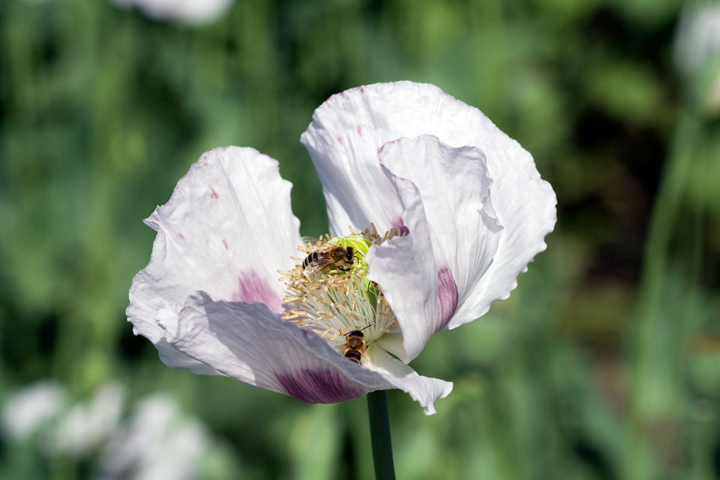
Flowering poppy (Papaver somniferum) (Photo: Radácsi)
The plant protection technology has to focus on prevention of disease. Only healthy seed treated with seed coating chemicals are suggested to use for sowing. The smaller plant density helps to reduce the risk of infection because rain and dew dries up quicker from the leaf surface. Registered fungicides against downy mildew in Hungary are as follows: Acrobat MZ WG, Dithane M-45, Manco 80 WP, Manzate 75 DF, Miltox SE, Penncozeb DG, Vondozeb DG, Indofil M-45.
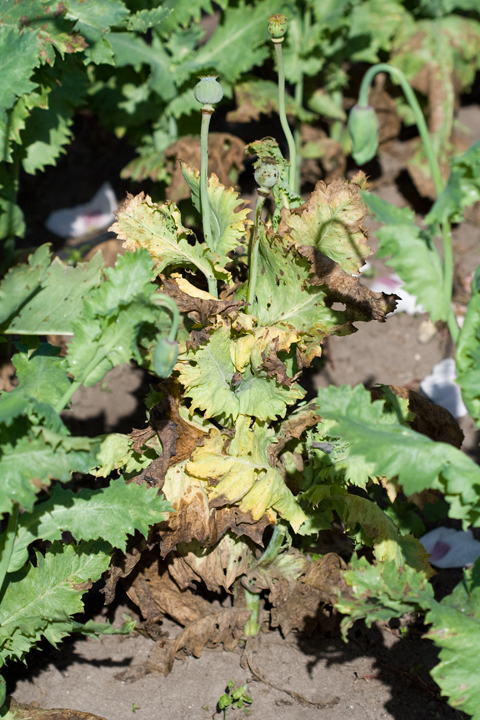
Primer symptom of downy mildew on poppy (Photo: Radácsi)
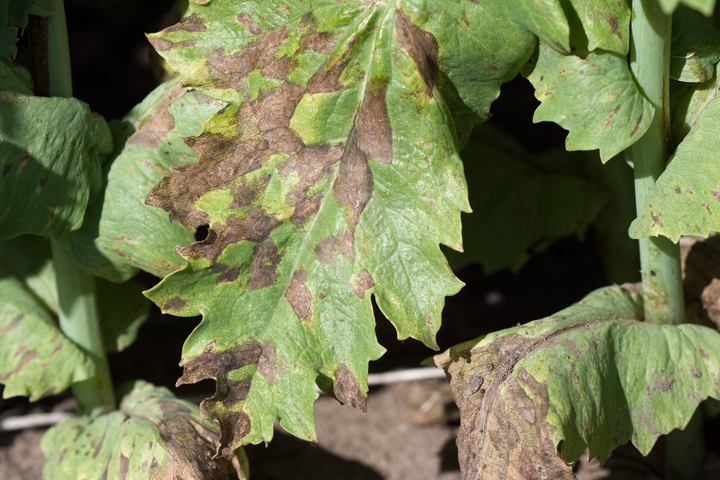
Secunder symptom of downy mildew on poppy (Photo: Radácsi)
Other considerable diseases of poppy are Dendryphion penicillatum and Pleospora papaveraceae. Warm and dry weather conditions - opposite to the optimal conditions, which were discussed in the case of mildew - can accelerate the spore germination of fungi. In the case of low plant density the infection occurs first at the edge of the crop stand. Later the pathogen distributes to the other part of the plantation. As it was mentioned previously the use of healthy, chemically treated seed material for propagation is cardinal. The plant protection can be made with the same fungicides which are registered for mildew.
The most dangerous insect, which harms the poppy culture, is the weevil (Ceutorhyncus macula-alba). This insect has one generation per year. The insect damages the plant in its young and adult development stages as well. The imago chews the leaves and other plant parts than lays eggs into the capsules. Later when the capsules appear the imago perforates the wall of the capsule, which causes latex effusion. The latex contains alkaloids, which may contaminate the seeds. The wounds on the capsule wall will give an opportunity to poppy fly (Dasyneura papaveris) to attack the plant laying her eggs into the capsule. The larvae of weevils leave the capsule by chewing themselves out of the wall of the capsule, than fall to the ground, where they dig itself into the soil with the purpose of overwintering. That is one of the reasons while the monoculture of poppy has to be avoided. According to the practical experiences the chemical plant protection has to be started when more than 2 imago per square meter in the crop appear. The pesticide Chlorpyrifos-methyl (Daskor) is allowed to be used against the insect. Because of the swarming period of the insect is long (even 6 weeks) the chemical treatment has to be repeated 2 or 3 times. The infection is most common in the case of cultivation of spring poppy ecotype. If the autumn ecotype is cultivated the flowering of the crop starts earlier and the possibility of the infection is much more limited. It does mean than the chemical protection of the autumn-sown ecotype can be omitted in some cases.
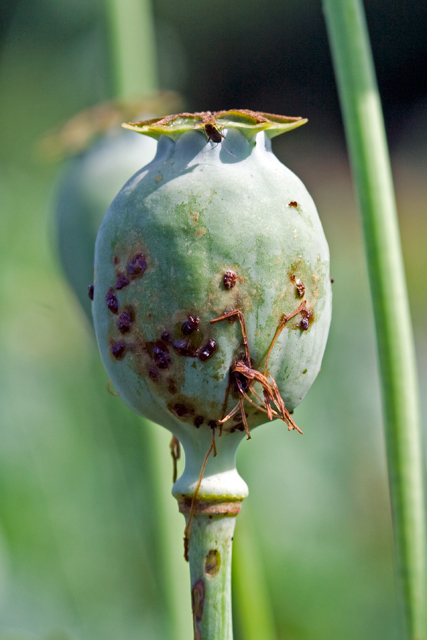
Damage of Ceutorhyncus macula-alba on raw poppy capsule (Photo: Radácsi)
The next dangerous insect of the poppy is the poppy fly (Dasyneura papaveris). The imago lays her eggs into the capsule by using wound made by imago of weevil, earlier. The wounded capsule, in which the larva masticates the ovules and the wall of the capsule, becomes mouldy and rotten. Main source of the infection is the contaminated soil, so the crop rotation can decrease the risk of the infection. The same insecticide can be used for plant protection which was mentioned before.
The black bean aphid and the green peach aphid (Aphis fabae, Myzus persicae) can attack the developing plants, mostly in its early bud stage. They appear on leaves and buds. They excrete honeydew which falls down onto the lower leaves where black mold (Stachybotrys spp.) can appear. It results secondary damage because of the reduction of the photosynthetic area of the plant. The aphids can be entrapped with a yellow bowl trap which is also good for forecast the swarming. Insecticide Pirimor 50 WG can be use to stop or prevent the attack.
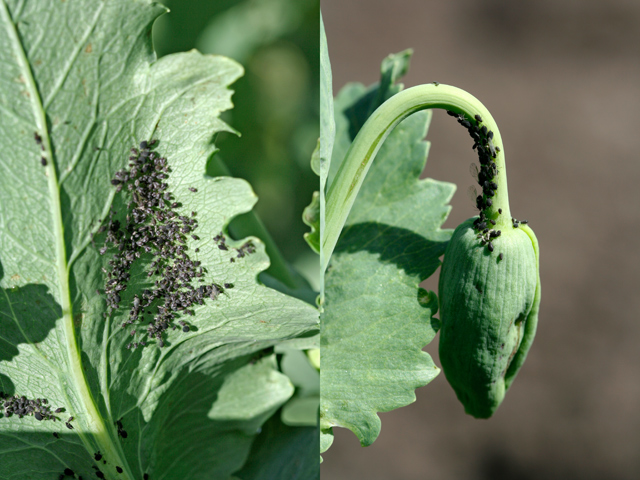
Damage of aphids on the leaf (left side) and bud (right side) of poppy (Photo: Radácsi)
The poppy does not have special weed but barn-yard grass, creeping thistle, couch grass and other perennial weeds can cause serious problems. Weed control is thus a crucial component of cultivation technology. If it is not performed correctly the crop may be spoiled. In herbicide technology, pre-emergent treatments have a great importance, while post-emergent applications are often substituted by manual work. The weed suppression ability of poppy is negligible until the 8-10 leaf stage. The waxy surface of the poppy facilitates the spraying of herbicides (the drops of the herbicides are falling down from the waxy surface of the leaves). But it should be mentioned that heavy rainfall can wash off this waxy layer, so the poppy becomes sensitive. Registered herbicides in Hungary are as follows: Callisto, Laudis, Command 48EC, Fusilade Forte, Lentagran WP, Lentipur 500 SC, Reglone, Solaris, Stomp 330, Tolurex 50 SC. Trend 90.
Plant protection of mustard (Sinapis alba, Brassica × juncea)
The species of mustard (white mustard – Sinapis alba; Indian mustard – Brassica × juncea) are in a close relationship with the rapeseed ( Brassica napus), that is why they have many common pests and diseases. Like the poppy they are also medicinal plants cultivated on a large-scale. The most dangerous parasitic fungi of the species is downy mildew (Peronospora brassicae). Sporangiophores with sporangia appears on the lower surface of the leaf, while the upper surface turns yellow and later dried spots on the leaves appear. Cold and damp weather conditions accelerate the infection. The risk can be reduced by application of proper agricultural techniques by using adequate nutrient supply or proper plant density. The white mold (Sclerotinia sclerotiorum), leaf blight (Alternaria brassicae) and Pythium debarianum, which infects the root, can occur occasionally. The infection can be prevented by using crop rotation. Against downy mildew biological pesticide Constans WG can be applied. However, there are no official pesticides against the other two fungal diseases in Hungary. The application of chemical coating of seed material before sowing may limit the risk of infection of all fungus mentioned before.
The most harmful insect of mustard, which attracts the young plants, is flea beetle ( Phyllotera spp.). The insect peels the surface of the leaves, and at the time of its gradation period can destroy the whole crop. At summer time the insect peels the stem of siliqua causing yield losses as a secondary damage.
The damage caused by the caterpillar of beet sawfly (Athalia rosae) was a serious problem in the seventies and eighties, but nowadays it is less important. The imago lays their eggs on the surface of young plants where the caterpillars are masticating the leaf between veins or gnaw off every leaf in serious cases. It may become more dangerous if its appearance is not detected in time. The beet sawfly has 3 generations in a year.
The cabbage stem weevil (Ceutorhyncus quadridens) is damaging the stem of mustard and rape. The imago gnaws small holes in the leaves, but this damage is not harmful. It makes much more problem if the larvae masticate the stem. Later they chew hollows into the stems and the strength and solidity of the stems is lost. Hard wind or heavy rains break the stem or topple it, which cause large difficulties at the time of harvest. The infection can be forecasted by application of Moericks yellow trap method or by regular monitoring of the plantation. If 1 or 2 imagos are detected in the stem of one individual the chemical protection should be started.
The pollen beetle (Meligetes aeneus), which eats the pollen has one generation per year, only. The damage is done by the imago. It smashes the stamen and the ovary of the flowers, which leads to the significant decrease of the yield. The female insect lays her eggs into the bud and the hatching larva also feeds on pollen. However, the damage caused by the larvae is less important comparing to the damages made by imagos. Serious damage can be prevented by using appropriate agricultural technique, like by use of proper varieties. The pesticide treatment has to be started if 2-3 insects are detected on one plant individual. Registered insecticides are as follows: Dursban Delta CS, Fendona 10 EC, Gazelle 20 SP, Karate 2,5 WG, Mospilan 20 SP, Reldan 22 EC.
The white and Indian mustard has no specific weed. The plant stand has good weed suppression ability if they get the right development stage. The cleavers may cause a problem in some growing sites climbing up the plants causing significant yield losses. Registered herbicides in mustard plantations in Hungary are as follows: Agil 100 EC, Brasan, Butisan 400 SC, Cliophar 300 SL,Galera, Paladin, Pantera 40 EC, Select 240 EC, Sultan 50 SC.
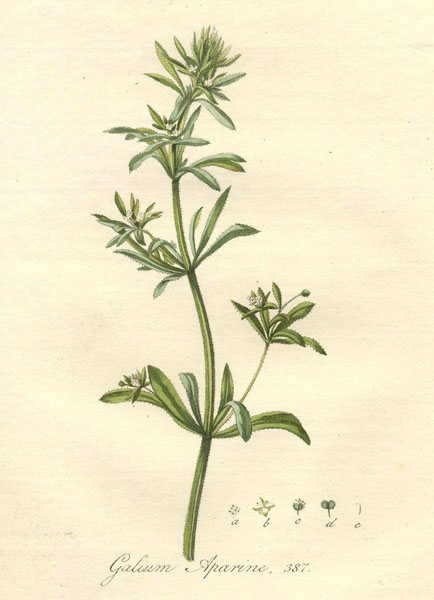
Galium aparine (Source: Kops, J., Christiaan van Hall, H., 1828 )
Plant protection of caraway (Carum carvi L.)
The cultivation area of caraway has decreased considerably in Hungary, compared to the nineties (from 5000-6000 to 100 ha). There are two life forms of caraway, which are represented by different varieties: annual and the biannual varieties. All steps of their cultivation are mechanized. The same machines and accessories are applied for its cultivation which are used for production of such large crops as wheat and maize.
The most frequent disease of caraway – and other Apiaceae species – is the powdery mildew (Erysiphe heraclei). The dry, hot weather can promote the infection. Farinaceous spots - caused by infection - are the symptoms which appear on the leaves, stem and inflorescences. The main source of the infection is the cleisthotecia, which can be found on crop residues, left on the field. There is no pesticide registered against this disease in Hungary. However, some pesticides are authorized in Germany (Folicur, Cuprosin, Ortiva, Score). Sulfur containing contact pesticides can be recommended against the pathogen, too.
In contrast with powdery mildew, the downy mildew (Plasmopara nivea) prefers the cool and wet weather conditions. It can cause massive damage only in years which are ideal for the pathogen. It spends the wintertime on plant residuals. During the vegetation period the soprangiospore released from grey sporangia on the lower surface of the leaf (secoundary infection). It does not require chemical treatment if we use adequate agricultural technologies. Permitted pesticides in Hungary: Cuprosan 50 WP, Montaflow, Neoram 37,5 WG
Cumin rust (Puccinia cari-bistortae) is a rarely appearing disease, other hosts are Angelica archangelica and A. sylvestris, so separation is advised in cultivation.
The most harmful insect is the caraway moth (Depressaria daucella) . The caterpillar masticates to the umbel and the fruit and weaves a net around it. First appearance is in April. The larva needs 4-5 weeks for the complete development. In this period we can protect against this insect with Bi 58 EC, Danadim Progress, Dimetoát Jubileum, Gazelle 20 SP, Mospilan 20 SP. The listed pesticides provide protection also against aphids. Other important pest is the caraway gall mite (Aceria carvi). It can appear on the leaves and floral stems due to the damage of the stems, leaves young flowers can deform which cause yield decreasing. There is no registered acaricide against caraway gall mite in Hungary. It is important to keep isolation distance from the new and old caraway cultivation field, and to turn the plant residuals proper to the ground.
The most dangerous weed of caraway plantation is the poison hemlock (Conium maculatum). It belongs to the same family, so the chemical protection is rather difficult. Liuron containing herbicide should be sprayed out pre- and postemergent way, until the plant reaches the 10 cm plant height. In the southern part of Hungary milk thistle (Silybum marianum) can cause weed problem but with a herbicide Racer the cultivation can be protected.
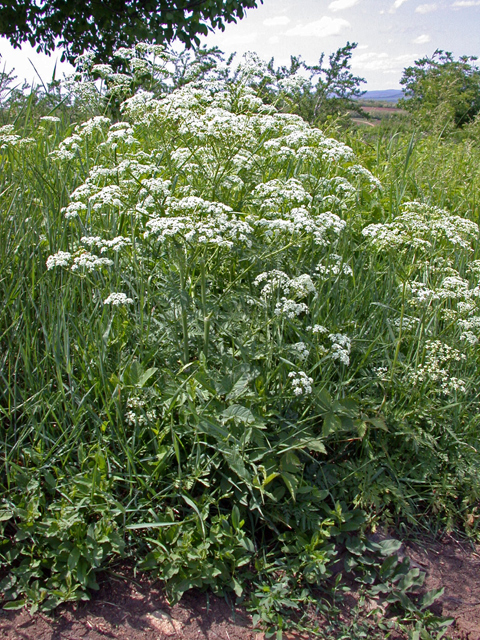
Conium maculatum (Photo: Bernáth)
Plant protection of mint species ( Mentha spp.)
Peppermint (Mentha × piperita) and spearmint (Mentha spicata var. crispa) are the main mint species cultivated in Hungary. There are some data about the cultivation of M. longifolia on a smaller-scale, also. All these species are perennial and they are cultivated through some years (usually 3 years).
Mint rust (Puccinia menthae) is the most frequent pathogen of mint, resulting foliar disease. The fungi overwinters in uredinia form creating telia on plant residuums overwintering part of the mint. Like in the case of many rust species, the life cycle is complex, the typical symptom of its infection appears at spring showing vivid orange colour caused by aecidiums on the lower surface of the leaf. The aeciospores (third spore stage) fell down to the surface of the soil and result pink coloration. As a result of infection the leaves start to fall down resulting large loss in the plant yield. The quality of remaining leaves, which are infected as well decrease. One of the protection methods is that the old plant stand has to be ploughed into the soil. The plants will be able to re-sprout again, but the infection stops. Effective chemical agents for chemical protection are as follows: mankoceb, difenoconazol, azoxystrobin.
Septoria leaf spot (Septoria menthae) is an other specific disease of mint species. However, its appearance is not rather frequent. The chemical protection used against rust is effective in the case of this fungus.
Evaluating the harming pests the two-spotted spider (Tetranychus urticae) can cause damage during the hot and dry summers. The mites are eating the lower surface of the leaf, and as a result small, light and silver spots appear on the leaf surface. In the case of intensive infection the pest spins a fine web on the leaves. The leaves, which are damaged, fall down.
Conspicuous, but less serious damage is made by aphids especially by the mint aphid (Ovatus mentharius). It can occur on the mint in all phases of vegetation period. The insects usually consume the top part of the shoots. The attacked leaves start to deform. The insects excrete honeydew which fall down onto the lower leaves where black mold appears. Aphids are important from other point of view because of they are vectors of the mint mosaic virus which harms the mint species. Insecticides which can be applied in mint cultivation are as follows: Callypso, Karate, Steward.
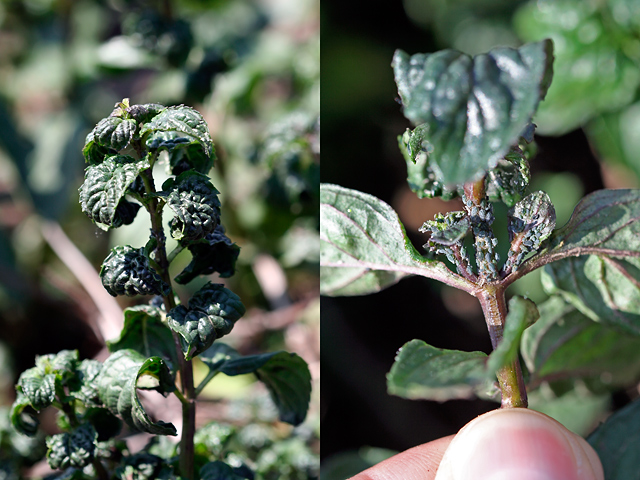
Damage of aphids on peppermint plants (Photo: Radácsi)
In the mint cultivation until the plant stand reaches the required plant density, which helps the suppression of weed flora, weed control should be made. During this period usually monocotyledons weeds are dominating. The herbicides can be applied in early springtime or immediately after the planting. It is important to note that there are no registered herbicides for this crop in Hungary. In Germany Ethosat 500, Select 240 EC, Basagran, Basta, Fusilade Max, Lentagran WP, Lontrel 100, Goltix Gold, Lentagran WP és Targa Super can be used.
Plant protection of the marjoram (Majorana hortensis L.)
Marjoram is a species, which needs a restricted activity on plant protection, only.
The mint rust (Puccinia menthae), which was discussed previously and the fungi early blight (Alternaria spp.) may infect the crop. The sources of disease are the infected plant residuums in the soil. In the early stage of infection small grey-brown spots appear on the leaves, which later fall down. Preventive plant protection method is the destruction of the infected plant residuums in the soil. The following fungicides can be used for prevention against both fungus: Dithane M-45, Indofil M-45, Manco 80 WP, Manzate 75 DF, Miltox SE, Penncozeb DG and Vondozeb DG.
For protection against the weeds herbicide Pendigan 330 EC can be used in preemergent form. This herbicide is rather effective against both mono- and dicotyledonous weeds.
New methods and the future possibilities of plant protection
The large scale industrial plant protection was started in early 20th century. „Bordeaux mixture” was one of the first chemical, which was applied for protecting plants. Since 1915 number of inorganic and organic chemicals used for plant protection have been spread out in the world. From 1940 the ratio of synthetic agents increased enormously. Against pests the DDT, for weed control 2.4 D became the most popular chemical, worldwide. Since that time the increase of the number of different synthetic pesticides is enormous and continues even nowadays. More recently large number of bio-based pesticides are developed, but only one the Bacillus thuringiensis preparation is applied on a large scale.
One of the new trends in the plant protection is the so called "Integrated Pest Management". It means a long-term, stable, effective plant protection system, in which the user tries to reduce the side effects of the application of pesticides. They want to minimise the contamination of the crop using the minimum effective amount of pesticides taking into consideration the specialities of the cultivated plant and the applied cultivation technology. In Hungary the decree 150/2004. (X.12.) FVM regulates "Integrated Pest Management" system. However, sorry to say no such a system exists in the medicinal and aromatic plant sector.
The other possible action to limit the amount of pesticides is, if we would mix it into the irrigation water. Not an up-to-date but a good method is to inject pesticides into the irrigation water. The operators are able to change the amount of pesticide easily and fast if it becomes necessary (depending on field conditions or cultivated species). By this method both the cost of chemical agent and fuel can be reduced. On the other hand it reduces the trampling damage of machines turnabout on the field.
The drift of pesticides is another danger we have to calculate with. It can be limited by application of electrostatic spray system. The droplets generated by this system are charged electronically which pull them to the ground to get back their neutral bound. Electrostatic attraction is generated between drop and the nearest ground clot. There are two ways to generate charge: the corona and the contact charging. According to certain calculations, with application of the electrostatic sprayer 20-25 % cost can be saved, and the surface-covering efficiency of pesticides is much better comparing with the conventional method. This method is not applied yet in large scale agriculture, it is mostly used for protection of vegetables and viticulture. Unfortunately, there is no information about its application in the case of medicinal plant crops.
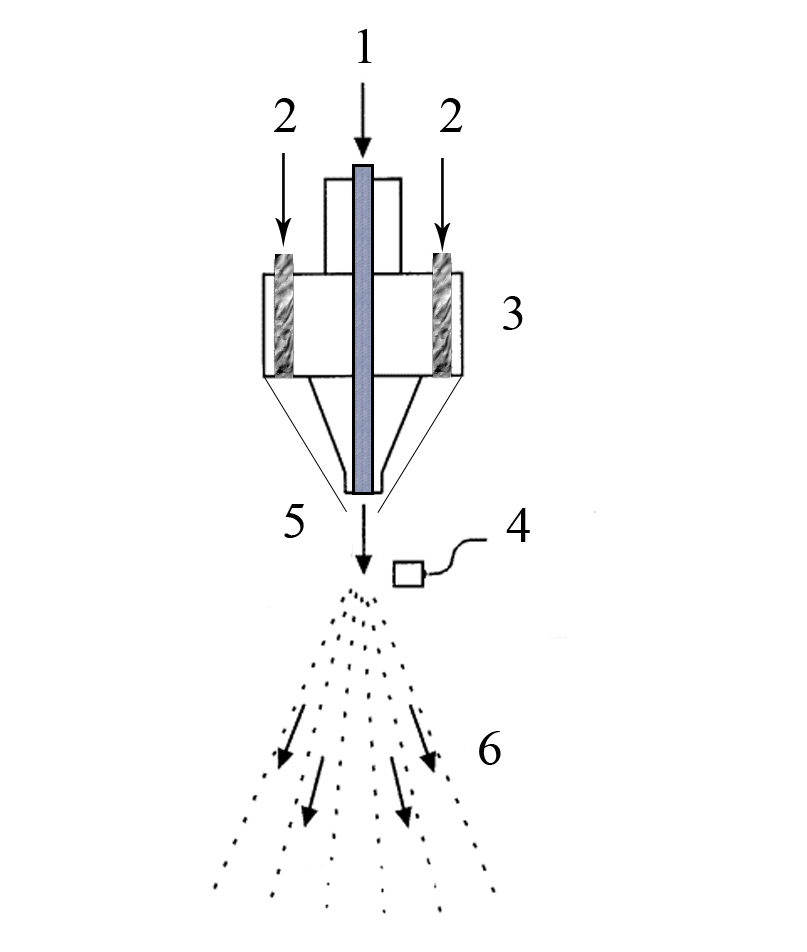
Block diagram of electrostatic spraying (gyógy_7.11.jpg) (1-pesticide, 2-air flow, 3-sprayer nozzle, 4-charger electrode, 5-charging zone, 6-charged particle)
The quality of spraying can be improved by air-curtain sprayers. This method reduces the drifting risk of the chemicals (pesticide, fungicide). The system is similar to the traditional irrigation. However, a hose is attached to the nozzle where a high intensity air flows, and that assists the droplets to move to the right direction. That movement usually has a vertically downward way. With this method the plant parts closer to the ground get a better coverage. It can be also used for vaporizing the spraying fluid.
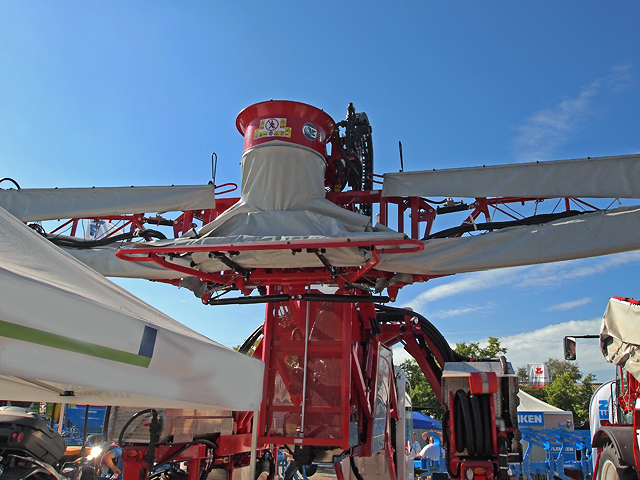
Air-curtain sprayer (Photo: Radácsi)
Control questions
b. Spraying out electronically charged droplets
c. Electrical grounded spraying equipments for protection against thunderbolts
b. Erysiphe umbelliferarum
c. Peronospora brassicae
b. The raw material should soak in cold water for several days (1-2 weeks)
c. The raw material should mix with cold water and boil till 220 °C
b. Milk thistle
c. Poison hemlock
b. Biodegradable active agent
c. The active agent should be synthesized from plant
d. Economical
Right answers
References:
Balás, G. (1963): Kertészeti növénye állati kártevői, Mezőgazdasági Kiadó, Budapest
Bernáth J. (1998): Poppy - The Genus Papaver. Harwood academic publishers, Amsterdam
Dimitrievits, Gy., Gulyás, Z., Kovács, L., Kalmár, I.: Anyagtakarékos permetezőgépek vizsgálatának eredményei,
Folk, Gy. és Glits, M. (1993): Kertészeti növénykórtan, Mezőgazda Kiadó, Budapest
Jenser, G., Mészáros, Z., Sáringer, Gy. (1998): A szántóföldi és kertészeti növények kártevői. Mezőgazda Kiadó, Budapest
Krusche, M. és Kusterer, A. (2011): Genehmigungen/Zulassungen der Planzenschutzmittelanwendungen im Arznei- und Gewürzpflanzenbau, Stand 22.12.2010., Zeischrift für Arznei-& Gewürzpflanzen, 16, pp. 5-18.
Manindra, M., S. Zafar, H., Harish, C. A., Vijay, K. P. (2011): Essential Oils as Green Pesticides: For Sustainable Agriculture, Research Journal of Pharmaceutical, Biological and Chemical Sciences 2 (4), pp. 100-106.
Molnár, J., Erdős, Gy., Ocskó, Z. (2012): Növényvédő szerek, termésnövelő anyagok 2012 I., Agrinex Bt.
Németh É. (1998): Caraway – The Genus Carum. Harwood academic publishers, Amsterdam
Opender, K., Suresh, W., Dhaliwal, G. S. (2008): Essential Oils as Green Pesticides: Potential and Constraints, Biopestic. Int. 4(1), pp: 63–84.
Sándor, F. (1978): Növényvédelmi technológiák 1979-1980, Mezőgazdasági Kiadó, Budapest
Satti, A.A., Elamin Ellaithy, M. E., Abdin, E. M. (2010): Insecticidal activities of neem (Azadirachta indica A. Juss) seeds under laboratory and field conditions as affected by different storage durations, Agric. Biol. J. N. Am., 1(5), pp: 1001-1008.
Ubrizsy, G. (1965): Növénykórtan I-II., Akadémiai Kiadó, Budapest

